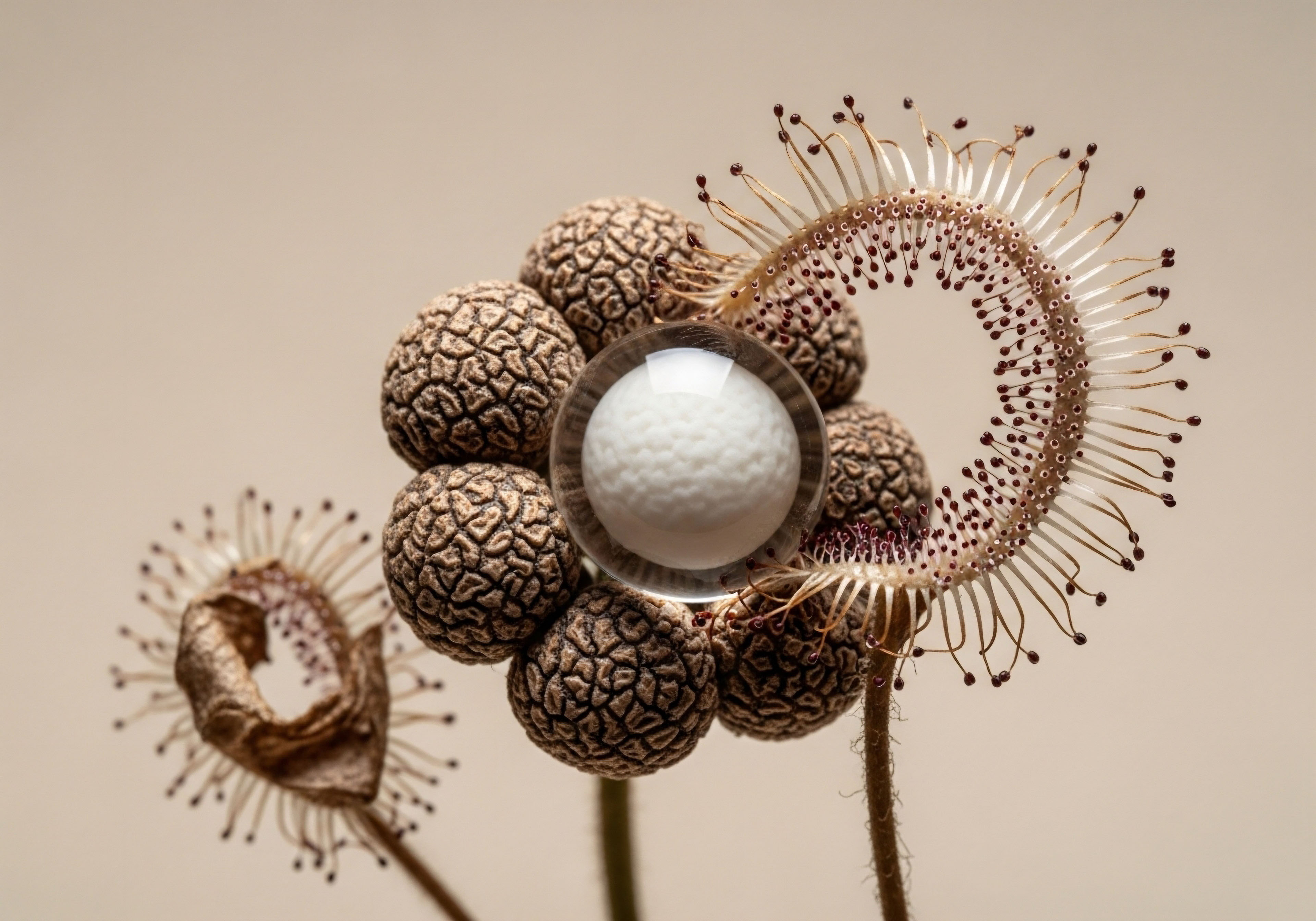

Fundamentals
Holding a small vial of lyophilized powder, you are at a significant starting point in your personal health protocol. This substance, which appears inert, contains molecules designed to communicate with your body’s intricate systems. The feeling of responsibility is understandable.
You are about to reawaken these molecules, and doing so with precision is the first step in harnessing their potential. The process of reconstitution is a careful and deliberate act of preparation, ensuring that the peptides you introduce to your system are in their most effective and biologically active state.

The Nature of Therapeutic Peptides
Therapeutic peptides are short chains of amino acids, the fundamental building blocks of proteins. Think of them as specialized keys, crafted to fit specific locks, or receptors, on the surface of your cells. When a peptide binds to its receptor, it transmits a signal that can influence a vast range of physiological functions, from metabolic rate and tissue repair to inflammatory responses and cognitive processes.
Their power lies in their precision. Unlike broader interventions, peptides can target specific pathways within the Hypothalamic-Pituitary-Gonadal (HPG) axis or other signaling systems, offering a focused method of biological optimization.
These molecules are inherently fragile. Their complex, three-dimensional structure is what allows them to function correctly. This structure is susceptible to degradation from heat, agitation, and enzymatic breakdown. To preserve their integrity for transport and storage, they undergo a process called lyophilization.
This is a sophisticated freeze-drying technique that removes water, leaving the peptide in a stable, crystalline state. Your task in reconstitution is to reintroduce a liquid solvent to this powder, restoring the peptide’s structure without damaging it.

Why Is the Correct Diluent Necessary
The fluid used for reconstitution is a critical component of the process. You will typically use bacteriostatic water, often abbreviated as BAC water. This is highly purified, sterile water containing a small amount of a preservative, 0.9% benzyl alcohol. The presence of benzyl alcohol is what makes the water “bacteriostatic,” meaning it inhibits the growth and reproduction of bacteria that might be accidentally introduced into the vial.
Once you puncture the vial’s rubber stopper, you create a potential entry point for contaminants. Sterile water, which lacks a preservative, would need to be used in its entirety immediately, as it offers no protection against subsequent bacterial growth.
Since peptide protocols often involve using a single vial for multiple doses over several weeks, BAC water is the standard for ensuring the solution remains safe and sterile for the duration of its use. This preserves the purity of the peptide and protects your own biological system from the introduction of harmful microbes.
Reconstitution is the careful process of dissolving a lyophilized peptide with a sterile diluent to activate it for therapeutic use.
Understanding these foundational principles transforms the task from a simple mechanical action into a mindful procedure. Each step you take is designed to protect the structural integrity and purity of these powerful signaling molecules. This precision ensures that your body receives the intended message, allowing you to move forward with your protocol confidently.


Intermediate
With a solid understanding of why proper reconstitution is so important, we can now turn to the practical application. The following steps provide a systematic, repeatable method for preparing your peptides. The goal is to perform these actions with a calm, focused attention to detail. This is your clinical protocol, and executing it with precision is integral to its success. Aseptic technique, which means preventing contamination, is the guiding principle throughout this entire process.

Assembling Your Materials
Preparation is a prerequisite for a smooth procedure. Before you begin, arrange all necessary items on a clean, disinfected surface. This prevents rushing and reduces the chance of error. Your workspace should be organized and free from clutter.
| Item | Purpose and Key Considerations |
|---|---|
| Lyophilized Peptide Vial | This is the vial containing the freeze-dried peptide powder. Allow it to reach room temperature before opening to prevent condensation from forming inside. |
| Bacteriostatic Water Vial | The sterile diluent containing 0.9% benzyl alcohol. Check the expiration date before use. |
| Sterile Syringe for Mixing | A larger syringe (e.g. 3mL or 5mL) is typically used for transferring the BAC water to the peptide vial. Ensure it is new and in a sealed, sterile package. |
| Alcohol Prep Pads | Used to disinfect the rubber stoppers of the vials to maintain a sterile field. |
| Sharps Container | An FDA-cleared container for the safe disposal of all used syringes and needles. |

A Step-By-Step Reconstitution Protocol
The following protocol is a standard procedure for reconstituting peptides like CJC-1295/Ipamorelin blends. The volumes may be adjusted based on the specific peptide and prescribed concentration, but the principles of handling remain constant.
- Preparation and Sanitization ∞ Wash your hands thoroughly. After allowing the vials to reach room temperature, remove the protective plastic caps from both the peptide vial and the BAC water vial. Vigorously wipe the exposed rubber stoppers with an alcohol prep pad and allow them to air dry.
- Drawing the Diluent ∞ Unpackage your mixing syringe. Pull back the plunger to draw air into the syringe, equal to the volume of BAC water you intend to withdraw. For example, if you need 3mL of water, draw up 3mL of air. Insert the needle through the center of the BAC water vial’s stopper and inject the air into the vial. This equalizes the pressure, making it easier to withdraw the liquid. Turn the vial upside down and pull the plunger back slowly to draw the desired amount of BAC water.
- Introducing the Diluent to the Peptide ∞ Insert the needle of the syringe containing the BAC water into the lyophilized peptide vial. Angle the needle so that the tip rests against the inner glass wall of the vial. Depress the plunger slowly and gently, allowing the water to run down the side of the vial. Do not inject the water directly onto the peptide powder. This gentle introduction is critical to prevent damaging the delicate peptide molecules through mechanical force.
- Dissolving the Peptide ∞ Once all the BAC water has been added, remove the syringe and dispose of it in your sharps container. To dissolve the powder, gently swirl the vial in a circular motion or roll it between your hands. Vigorous shaking can cause the peptide chains to break apart or clump together, a process known as aggregation, which renders them biologically useless. The powder should dissolve completely within a few minutes, resulting in a clear solution.
- Proper Storage ∞ Once reconstituted, the peptide solution must be stored correctly to maintain its potency. Label the vial with the date of reconstitution. Place the vial in a refrigerator, stored upright at a temperature between 2°C and 8°C (36°F and 46°F). Protect it from light and do not freeze the reconstituted solution, as freeze-thaw cycles can degrade the peptide.
Gentle handling during mixing is paramount, as aggressive shaking can denature the peptide molecules and compromise their efficacy.

What Are the Best Practices for Dosing and Administration?
After reconstitution, the peptide is ready for administration, typically via subcutaneous injection into the adipose tissue of the abdomen or thigh. Using a new, smaller insulin syringe (e.g. a 1mL U-100 syringe), you will draw your prescribed dose from the reconstituted vial.
The process is similar ∞ wipe the stopper with alcohol, draw air into the syringe equal to your dose, inject the air into the vial, and then withdraw the medication. This meticulous attention to sterile technique at every step ensures the safety and effectiveness of your protocol, connecting your careful preparation directly to the biological outcome you seek.


Academic
A sophisticated understanding of peptide therapy requires an appreciation for the molecular biochemistry that governs the stability and function of these molecules. The reconstitution process is a practical application of principles from pharmacology and protein chemistry. The lyophilized state represents a suspension of kinetic activity, while the reconstituted aqueous state reinitiates the molecular dynamics that can lead to either therapeutic action or degradation.
The success of a protocol is therefore dependent on minimizing the chemical and physical instabilities that peptides are susceptible to in solution.

Mechanisms of Peptide Degradation
The biological activity of a peptide is dictated by its precise primary, secondary, and tertiary structure. Any alteration to this structure can compromise its ability to bind to its target receptor. In an aqueous environment, peptides face several degradation pathways.
- Physical Instability (Aggregation) ∞ This is a process where peptide molecules interact with each other to form larger, often insoluble, complexes. Aggregation can be initiated by changes in temperature, pH, mechanical stress (like shaking), or interaction with surfaces. Hydrophobic regions of the peptide, normally buried within its structure, can become exposed and interact with those of other molecules, leading to the formation of non-functional aggregates. This process is a primary reason why gentle swirling is mandated over shaking during reconstitution.
- Chemical Instability (Oxidation) ∞ Certain amino acid residues, particularly methionine, cysteine, tryptophan, and histidine, are susceptible to oxidation. This chemical reaction, often catalyzed by trace metal ions or exposure to oxygen, modifies the amino acid side chains. Such modification alters the peptide’s structure and function. The use of high-purity water and minimizing the solution’s exposure to air are practical steps to mitigate this risk. In some pharmaceutical formulations, antioxidants may be included as excipients to protect against oxidative damage.
- Deamidation and Hydrolysis ∞ Deamidation is a reaction affecting asparagine and glutamine residues, while hydrolysis involves the cleavage of the peptide bonds themselves. These reactions are often pH-dependent and occur over time in an aqueous solution, representing a key factor in determining the shelf-life of a reconstituted peptide.
The stability of a reconstituted peptide is a dynamic state influenced by a matrix of environmental and chemical factors.

How Does Formulation Impact Peptide Stability in China?
The regulatory environment governing pharmaceuticals and cosmetic ingredients has a direct impact on the availability and formulation of peptides. In China, the National Medical Products Administration (NMPA) oversees the registration and approval of these substances. The regulatory framework for peptides, particularly for cosmetic use, is evolving.
As of late 2024, China’s Inventory of Existing Cosmetic Ingredients (IECIC) lists a small fraction of the peptides approved in Europe or the United States, indicating a stringent but growing market. For therapeutic peptides used in clinical research or medicine, the regulations are even more rigorous, governed by the Drug Administration Law.
This regulatory landscape influences formulation strategies. Companies seeking to introduce new peptide ingredients in China must navigate the New Cosmetic Ingredient (NCI) application process, providing extensive data on safety and stability. This process incentivizes the development of highly stable formulations.
The choice of excipients, buffers, and preservatives in a peptide product is therefore a result of both biochemical necessity and regulatory scrutiny. For an individual sourcing peptides for a research or therapeutic protocol, understanding this context reveals that the formulation in the vial is a product of intensive scientific development and strict compliance pathways designed to ensure its integrity from manufacturing to the point of reconstitution.
| Factor | Biochemical Mechanism | Best Practice for Mitigation |
|---|---|---|
| Temperature | Higher temperatures increase the rate of all chemical degradation reactions and can induce unfolding, exposing hydrophobic cores that lead to aggregation. | Store lyophilized powder in a cool, dark place. Store reconstituted solution in a refrigerator at 2-8°C. Avoid temperature fluctuations. |
| pH of Diluent | Each peptide has an isoelectric point (pI) at which it has no net charge and is often least soluble, increasing aggregation risk. The pH also affects rates of deamidation and oxidation. | Use the recommended diluent (e.g. BAC water, which has a pH of approximately 5.7) to maintain an optimal pH environment. |
| Mechanical Stress | Vigorous shaking or agitation introduces energy that can overcome the forces holding the peptide in its correct conformation, leading to denaturation and aggregation. | Gently swirl the vial to dissolve the peptide. Do not shake. Handle the vial with care. |
| Contamination | Bacterial or fungal growth introduces proteases that can enzymatically cleave the peptide, destroying it. Microbial presence also poses a direct health risk. | Strictly adhere to aseptic technique. Use bacteriostatic water and sterile, single-use syringes. Disinfect vial stoppers. |
The meticulous practices for peptide reconstitution are a direct application of these academic principles. Each step is a control measure against the forces of degradation. By managing temperature, minimizing mechanical stress, and ensuring sterility, you are actively preserving the sophisticated molecular architecture required for the peptide to perform its designated function within your endocrine and metabolic systems.

References
- Schramm, Holly. “How to Properly Mix, Measure, and Store Peptides.” Paradigm Peptides, 8 October 2020.
- Wittmer Rejuvenation Clinic. “What Is Bacteriostatic Water and How Is It Used?” Wittmer Rejuvenation Clinic Blog, 2024.
- United States Pharmacopeia. “Best Practices for Reconstitution of USP Peptide Reference Standards.” USP.org, 2022.
- ZMUni Compliance Centre. “Unlocking Opportunities in China’s Booming Peptide Market ∞ Key Insights and Compliance Pathways.” ZMUni, 11 October 2024.
- Virility Inc. “Mixing and Injection Instructions for CJC-1295/Ipamorelin.” Virility Inc. Patient Resources.
- JPT Peptide Technologies. “How to Reconstitute Peptides.” JPT.com, 2024.
- “Factors affecting the physical stability (aggregation) of peptide therapeutics.” Interface Focus, vol. 7, no. 6, 2017.
- “Designing Formulation Strategies for Enhanced Stability of Therapeutic Peptides in Aqueous Solutions ∞ A Review.” Pharmaceutics, vol. 15, no. 3, 2023.
- “Drug Administration Law of the People’s Republic of China.” National People’s Congress of the People’s Republic of China, 26 August 2019.
- Wang, Y. et al. “Evolving drug regulatory landscape in China ∞ A clinical pharmacology perspective.” Clinical and Translational Science, vol. 14, no. 4, 2021, pp. 1195-1205.

Reflection

Translating Knowledge into Personal Practice
You have now journeyed from the foundational ‘why’ to the procedural ‘how’ and the molecular ‘what’ of peptide reconstitution. This knowledge provides a framework for action, transforming a potentially intimidating task into a controlled and understandable part of your wellness protocol.
The vial of powder is no longer an unknown but a concentration of potential, waiting for your careful and informed preparation. Consider how this detailed understanding of the process changes your relationship with your own therapeutic journey. Each step, from wiping a vial stopper to gently swirling a solution, becomes an act of personal investment in your biological future.
This is the point where clinical science becomes a personal practice, and where you take an active, authoritative role in the stewardship of your own health.



